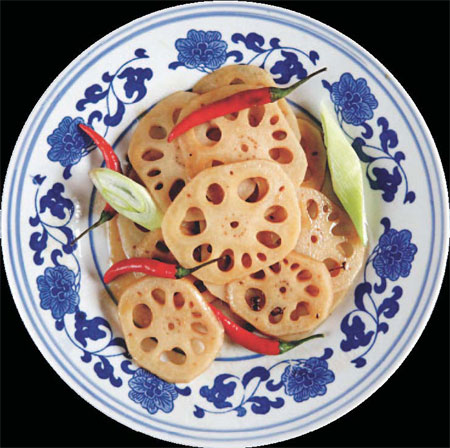Ou, ou, it's magic
Updated: 2012-07-27 12:17
By Caroline Killmer (China Daily)
|
|||||||||||
|
Suanla oupian, or sour and spicy lotus root, is a popular Chinese dish in summer. Photos Provided to China Daily |
Cool your jets with the mouthful of flavor that is suanla oupian
炎炎夏日,来一盘五味俱全的酸辣藕片吧!
The beautiful thing about the Tao Te Ching is that it is open to the reader's interpretation. So while "五色令人目盲,五音令人耳聋,五味令人口爽" (Wǔ sè lìng rén mù máng, wǔ yīn lìng rén ěr lóng, wǔwèi lìng rén kǒu shuǎng) from chapter 12 is often interpreted as "the five colors blind the eye, the five tones deafen the ear, the five flavors dull the taste," DJ and cooking enthusiast Eddie Lu prefers to consider the similarities between the aural and the edible rather than their potential to overwhelm.
In China, food and music align in more places than initially meet the eye, Lu says. The Chinese pentatonic scale, 五音 (wǔ yīn), provides the foundation for traditional Chinese music. By the Western sing-a-long method, that means it includes do, re, mi, so and la, skipping fa and ti.
"If a person is tone deaf, when they sing they go out of tune, they're off-pitch (五音不全wǔ yīn bù quán). So if you want to sing or you want to make music, you must have precise wu yin," Lu explains.
Chinese cuisine is also built upon the five flavors of sour (酸 suān), sweet (甜 tián), bitter (苦 kǔ), spicy (辣 là) and salty (咸 xián).
"When cooking, you use the five flavors to adjust for people's tastes, balancing every flavor. It's very similar to making music," Lu says.
For Lu, the correlation is one he feels both at the stove and behind the turntables.
"Cooking and making music are both creative activities, with multiple styles ... A lot of people who make music like to cook too," he says.
Most jiachangcai (家常菜 homestyle dishes) incorporate at least three of the five flavors, but suanla oupian (酸辣藕片) or sour and spicy lotus root captures every taste but the bitter, which suits many Beijing residents just fine.
"Many people who've had the ‘Beijing vagabond' experience (北漂 běipiāo, meaning to migrate to the north) don't like to eat bitter foods, because during that time they ‘ate a lot of bitterness' (吃苦 chīkǔ, suffered)," Lu says.
North America and Europe missed the ou boat, keeping lotuses only as ornamental plants, but in China, ou has a long history of cultivation.
Its nutritive properties merited reference in the Compendium of Materia Medica (《本草纲目》) nearly 500 years ago, where it is described as being able to "交心肾,厚肠胃,固精气,强筋骨,补虚损,利耳目,除寒湿,止脾 泄" (connect the heart and kidney, strengthen intestines and stomach, solidify essential qi, invigorate bones and muscles, heal weakness and injuries, benefit eyes and ears, expel coldness and dampness and cure diarrhea caused by a weak spleen).
Above the surface, the lotus blossom has been used for over 2,000 years as a metaphor for beauty: "彼泽之陂,有蒲与荷。有美一人,伤如之何?" (By the bank of the pond, weeds and lotuses grow. There is a beauty, and how I miss him.)
Suanla oupian is an easy-to-make dish that, when done right, blends crisp textures with a perfect ensemble of flavors. It is ideal for vegetarians, yet hearty enough for carnivores. The root's veritable heritage means it is never out of place at fancy banquets, while its starchy nutrition makes a nice addition to a typical working class family meal.
Much of the lotus plant is edible, with the roots and seeds in particular extolled as having exceptional health properties. The root is touted for its ability to sooth the spleen and stomach as well as to reduce bloating and stress, and it is often recommended that women suffering from the discomforts of menopause give ou a go.
Of all its benefits, the ability to cool inflamed tempers is perhaps ou's most oft-touted attribute. Old wives' tales correlate the shape of ou - a long root of dense flesh interrupted by holes traversing its full length - with its palliative effect on anger. The holes, it is said, serve as tunnels that allow negative qi (气) to flow out of the body, a process often dubbed 吃藕顺气 (chī ǒu shùn qì). Thus, eating ou calms a person down better than a stiff drink ever could.
Western science might be more inclined to ascribe the calming effect to its make-up; lotus root is chock-a-block full of fiber and nutrients like vitamins B6 and C, copper and potassium. It is also primarily composed of starch, which helps transport serotonin, that fickle neurotransmitter on which human happiness so relies.
Root vegetables like ou are an ideal starch source, as they help boost your mood without tacking on the sugar crash often brought on by other foods. So the next time you are having a bad day, just fire up the wok and the stereo and rock out with suanla oupian.
Courtesy of The World of Chinese www.theworldofchinese.com
The world of Chinese
Today's Top News
Rescuers race against time for quake victims
Telecom workers restore links
Coal mine blast kills 18 in Jilin
Intl scholarship puts China on the map
More bird flu patients discharged
Gold loses sheen, but still a safe bet
US 'turns blind eye to human rights'
Telecom workers restore links
Hot Topics
Lunar probe , China growth forecasts, Emission rules get tougher, China seen through 'colored lens', International board,
Editor's Picks

|

|

|

|

|

|






